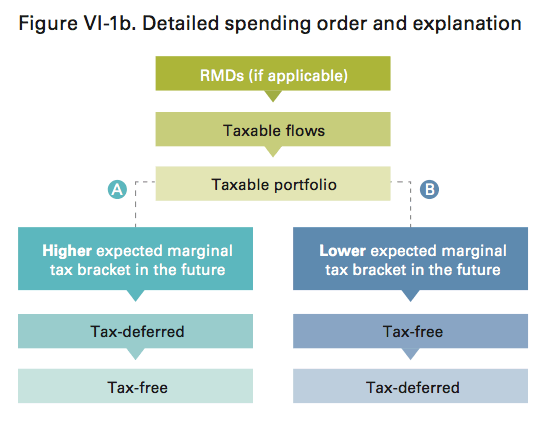According to research from the Vanguard Group, another area where a skilled financial advisor is supposed to able to add value is helping retirees manage withdrawals from their portfolios in order to minimize taxes. According to their paper:
Advisors who implement informed withdrawal-order strategies can minimize the total taxes paid over the course of their clients’ retirement, thereby increasing their clients’ wealth and the longevity of their portfolios. This process alone could represent the entire value proposition for the fee-based advisor.
The paper goes on to show how correct ordering can improve returns by up to 0.70% annually versus people with multiple different account types withdrawing in the wrong order. The thing is, ordering your withdrawals properly isn’t all that complicated. Most of it is summarized in this flowchart:

- RMDs stand for required minimum distributions. In general, these are forced withdrawals from pre-tax “traditional” IRAs (including SEP and SIMPLE IRAs) and pre-tax workplace defined-contribution plans (including 401(k) and 403(b) plans) once you reach age 70.5. Since it is mandatory and taxed at ordinary income rates, you may as well spend them first.
- Next, taxable flows include things like interest, dividends, and capital gains distributions that are already being “spun off” from your taxable portfolio. These are also going to be taxed no matter what anyway.
- Next, spend your taxable portfolio itself by selling shares and paying any capital gains taxes that may be due. Sell investments with the lowest gains first to minimize taxes. Don’t sell if you don’t need the money.
- What you have left are tax-deferred or tax-free (Roth) accounts. Do you want to pay taxes now, or later? If you think your marginal tax bracket will be higher in the future, then you should pay taxes now (withdraw first from tax-deferred account). If you think your marginal tax bracket will be lower in the future, then you should pay taxes later (withdraw first from Roth accounts). You could make your decision differently each year depending on your current situation.
 The Best Credit Card Bonus Offers – 2025
The Best Credit Card Bonus Offers – 2025 Big List of Free Stocks from Brokerage Apps
Big List of Free Stocks from Brokerage Apps Best Interest Rates on Cash - 2025
Best Interest Rates on Cash - 2025 Free Credit Scores x 3 + Free Credit Monitoring
Free Credit Scores x 3 + Free Credit Monitoring Best No Fee 0% APR Balance Transfer Offers
Best No Fee 0% APR Balance Transfer Offers Little-Known Cellular Data Plans That Can Save Big Money
Little-Known Cellular Data Plans That Can Save Big Money How To Haggle Your Cable or Direct TV Bill
How To Haggle Your Cable or Direct TV Bill Big List of Free Consumer Data Reports (Credit, Rent, Work)
Big List of Free Consumer Data Reports (Credit, Rent, Work)
As a financial advisor to a number of clients in retirement I agree that one of the most important areas where I can add value is help with withdrawals in retirement as a part of their overall spending plan. I had not read the VG but will try to get through it over the weekend.
As a financial planner that primarily advises clients in retirement, I disagree, in that the most efficient withdrawal order depends very much on the unique particulars of the client’s situation, including how much is held in each type of account, how much is needed annually (now and later), what the other income is and its taxability (now and later), and what are the legacy goals. One example that might materialize by following the flowchart method without considering the bigger picture: Before his RMDs begin, a retiree draws from his taxable portfolio for all his cash flow, resulting in very little (or even negative) taxable income during these years. He depletes his taxable portfolio during this time. Having no tax-free assets (e.g. Roth IRA), he starts drawing from his tax-deferred assets (e.g. IRA), for all his cash flow. Now every dollar he takes out is recognized as taxable income, which means he actually has to withdraw more just to pay the taxes on these funds. The result is a tax spiral where he effectively has to pay more and more (in our progressive tax system) for the total of his withdrawals in a year, depleting his assets faster than necessary. A skilled financial planner can evaluate whether a client’s portfolio has this risk, and if necessary, devise a withdrawal plan to help “smooth” the taxable income recognized over retirement years to minimize the tax bite.